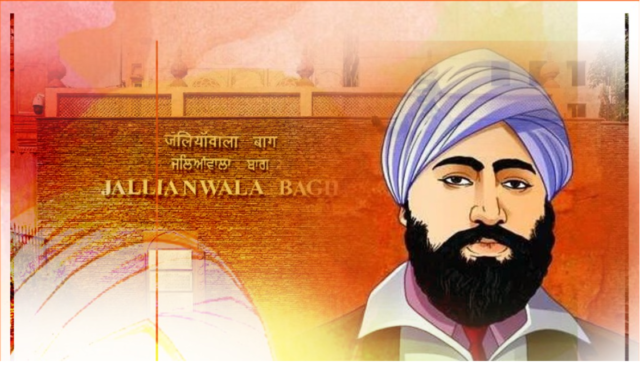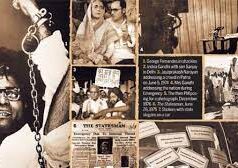
There are many freedom fighters in India whose names are not taken, and people do not even know about these people. But we should not forget that these people have laid down their lives for our nation. One of them is Balidani Udham Singh. Udham Singh killed General Dyer in London, who opened fire on unarmed people gathered for a meeting at Jallianwala Bagh in Amritsar, Punjab, in 1919.
Balidani Udham Singh was born on 26 December, 1899 in Sunam village of Sangrur district of the Punjab province. His father was Tehal Singh Kamboj, who used to work as a watchman at the railway crossing in the nearby village of Upalli. His family was ordinary. After the death of his mother in 1901 and his father in 1905, he grew up with his elder brother Mukta Singh Kamboj in the Central Khalsa Orphanage. As a child, Udham Singh was called by the name of Sher Singh. This orphanage was run according to the customs of the Sikh community. Hence Mukta Singh was renamed to Sadhu Singh and Sher Singh to Udham Singh. Since childhood, both these brothers were taught Sikh customs very well. Udham Singh was brilliant since childhood. While living in the orphanage, Udham Singh was greatly interested in arts and crafts. He passed the matriculation examination in 1918 and left the orphanage in 1919. Meanwhile, his brother Mukta Singh died in 1917.
When Lord Minto II became the Viceroy of India in 1905. Who, with Lord John Morley, sponsored the Morley-Minto Act in 1909. The Act marginally increased Indian representation in government but was criticized by Indian nationalists for creating separate electorates for Hindus and Muslims; they believed it created a rift among Indians to clear the way for British rule. The Act was intended to be amended every ten years. In 1919 this Act became known as Rowlett Act. According to this Act, there should be no trade union; there cannot be strikes. Also, if anyone is found to be doing any lethal activity against the government, he should be immediately arrested. There was a provision in this Act to act against anyone, even if there is only apprehension. This Act was opposed all over the country, and the significant opposition was from Punjab province.
On 10 April 1919, many leaders, including Dr. Satyapal Singh and Saifuddin Kitchlu, associated with the Indian National Congress, were arrested. All these people were protesting this act. Many people had gathered peacefully in Jallianwala Bagh, Amritsar, to protest the arrest of these people. That day was 13 April 1919, the day of Baisakhi, where more than 20 thousand people had gathered to oppose this act. Udham Singh and some of his companions were doing the work of giving water to this gathering. The then temporary Brigadier General of Punjab, General Dyer, ordered his soldiers to fire indiscriminately at all the people who came to this peaceful meeting. There was only one gate to enter this garden. All of them were shot on General Dyer’s orders without warning. It is considered that over 1500 people were killed in that incident, and more than 1200 people were severely injured. Udham Singh was greatly disturbed by this incident. He blamed General Dyer for this right accident. It can be said that many heroes of India, like Bhagat Singh and Udham Singh, were upset by this incident and decided to give their life to the motherland.
Shortly after this incident, Udham Singh moved to America, where he worked for the Ford Company. There he spent some time with the group of Babar Akali. When he returned to India, he brought some pistols from there. But under the Arms Act, he was arrested by the Amritsar Police and had to pay four years’ imprisonment.
Even after returning, he was given a lot of trouble by the police. Despite all this, he was looking for an opportunity when he gets a chance to avenge the incident in Jallianwala Bagh. The hanging of Bhagat Singh deeply saddened him in 1931 because Udham Singh was greatly influenced by Bhagat Singh’s movement and considered him his guru.
At that time, Dyer, who opened fire on unarmed people in Jallianwala Bagh, was living in London. In 1935, Udham Singh went to London to avenge Jallianwala Bagh. There he worked as a man in crowd scenes in several plays at
London Studios. In 1938 he also worked as a carpenter. Dyer was to speak at a joint meeting of the East India Association and the Central Asian Society at Caxton Hall London on 13 March, 1940. Udham Singh decided to take full advantage of this opportunity. That day he dressed up as an Englishman and reserved a place for himself in that hall. To kill Dyer, he made a place in a book and kept the gun in that book. When Dyer approached the stage to speak, Udham Singh fired two bullets. One of the bullets was ejected through Dyer’s heart and right lung, causing his death on the spot. He took revenge for the death of those martyred in Jallianwala Bagh after 20 years on the ground in London.
Soon after this incident, Udham Singh was arrested and charged with murder on 1 April, 1940. He was hanged on 31 July, 1940 in Pentonville Prison. His remains are preserved at Jallianwala Bagh in Amritsar, Punjab. Udham Singh avenged the deaths of his fellow citizens by going to the enemy’s soil, making his supreme sacrifice for India’s freedom, and marking his name in history. We pay our homage to the son of India, Sardar Udham Singh.














